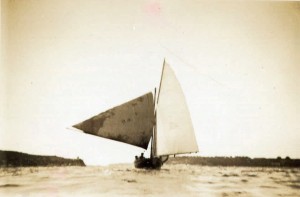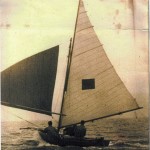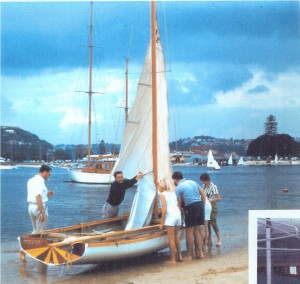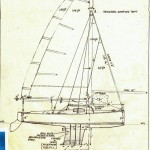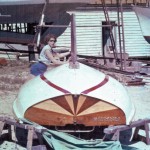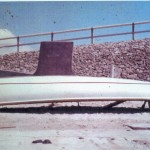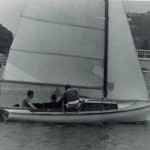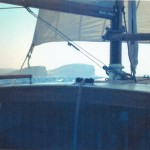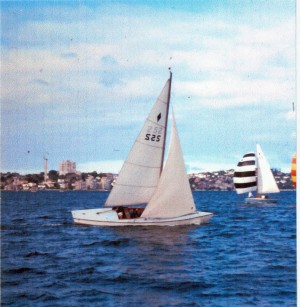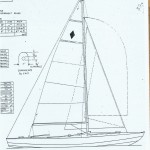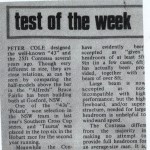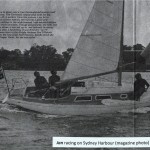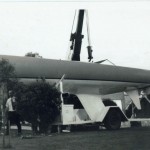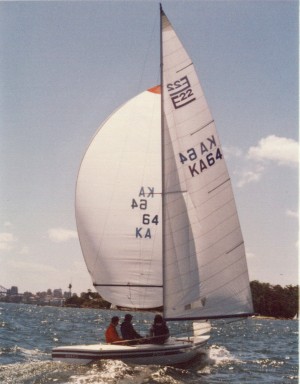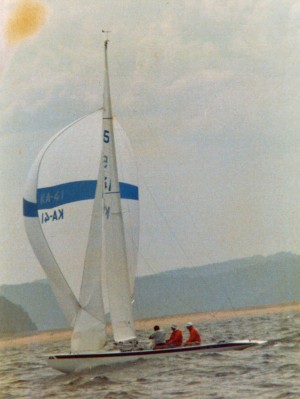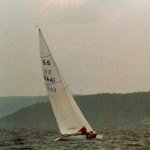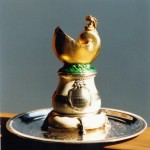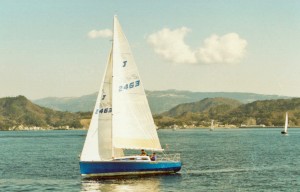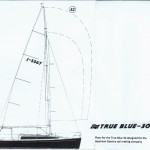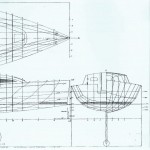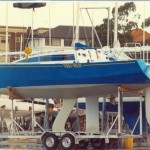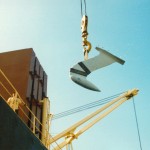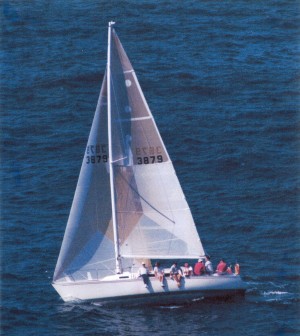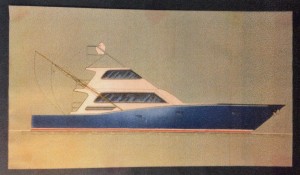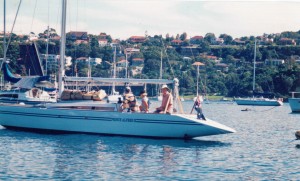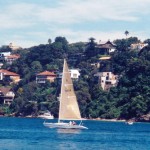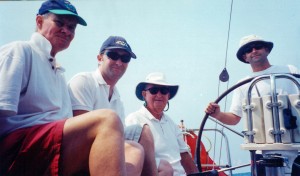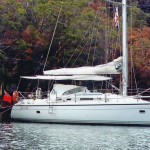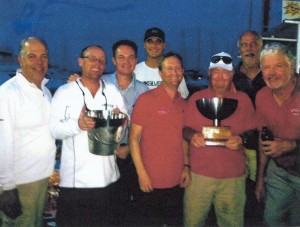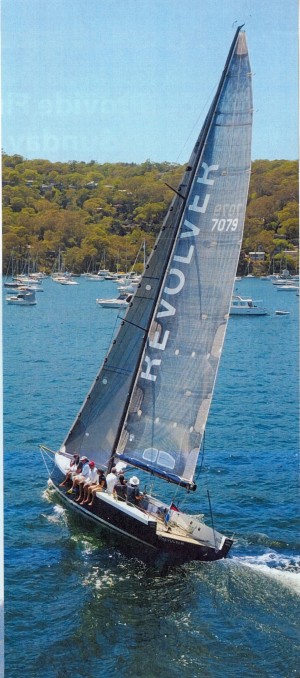| Bruce Ritchie | |
|---|---|
 | |
| Gender | Male |
| Nationality | Australian |
| Hometown | Sydney |
| Club | Middle Harbour Yacht Club Royal Prince Alfred Yacht Club |
| Boat Owner of | Cabriolet Royal Dawn Jan 1 Jan 2 Jan 3 Jan 4 Jan 5 Jan 6 Jan 7 Jan 8 Jan 9 Kunapipi (Miss Dulux) Penelope Prince Alfred II Revolver Sachiko Solo Union |
| Boats Sailed On | Kintama Seabee |
Bruce Ritchie
Summary: Extract from Letter to MHYC from Bruce
From early 1950's to 1956 Bruce sailed with Charlie Bullbrook on 'Seabee' in Division l. During this time he was also sailing in the Finn Class in readiness for the Melbourne Olympics. In 1957 he represented Australia in the World 505 Class Championships in La Baule, France finishing 23rd out of 60 starters.
1959 - He purchased 'Miss Dulux' the 18 footer from Alf Beashel, grandfather to Olympian Col Beashell. He named the l8 footer 'Kunapippi' and raced her in the winter series finishing first in every race. MHYC banned the boat from racing unless he fitted a fixed keel in place of the centreboard. He built the first FRP/ foam filled /lead filled keel in Australia and raced the I8 footer as a keelboat in Division 2.
1960 - Bruce built 'Sakico' the first Yachting World Keelboat outside of the UK and stepped one of the first aluminium masts to be made in Australia. "Max Dimmitt and I held the first meeting of the new class in the bar of the old Hotel Mosman. From this beginning the Australian Keelboat Class formed and I was the initial chairman of the class."
1963 - Won the Australian and State Championships in Keelboats and a class for Keelboats was later formed at Middle Harbour Yacht Club.
1964 - Commissioned the building of the first of the second generation keelboats. This boat was built by Ron Baulkwell and Ken Minter in Careening Cove. Named 'Jan', she featured beautiful mahogany varnished hull and laid teak decks. Bruce raced her successfully in the Keelboat class at the club. Also raced her at Lake Macquarie, Melbourne, Pittwater and against other harbour clubs achieving some 63 wins and places, including the club Pointscore.
1967 - Finished off a Peter Cole designed Contessa 25' sloop 'Jan II' which he raced in second division with some success. A new visitor to the club started racing with Bruce, one Keith Tierney. "In a drunken state, I nominated Keith for MHYC membership".
1971 - Keith Tierney purchased the S&S designed 'Kintama' and I happily crewed with Keith in many sobering and successful races.
1974 - Finished off in his front garden 'Jan III' an Etchell class one design sloop to be followed by another Etchell, 'Jan IV'. He won Club Championships, one third placing and three consecutive Australian Championships.
1976 - Bruce was nominated best Australian yachtsman by Modern Boating. The presentation included winning sponsorship to the Etchell World Championships to be held in Newport, Rhode island, USA. He was asked to name his crew to be sent with him "My forward hand was a young and nimble "Steamer" John Stanley. We stayed in the mansion right opposite the Ida Lewis Yacht Club of Americas Cup fame, in the suite once occupied by the Duke and Dutches of York. We were entertained in the famous "Breakers" mansion owned by the famous America's Cup yachtsman Cornelius Vanderbilt. In a borrowed, rather un-tuned E22 we came 3rd in the 1976 World Championships, actually, we could have won the Worlds if race 7 had finished within the time limit."
1977 - Raced in the first international match race series to be held in Australia and finished second to Sir James Hardy.
1978 - Designed the 'Seaflyer 30' complete with the first design for a fully functional winged keel.
I980 onwards - A number of 'Seaflyers' were successfully built and some are still racing today. Bruce launched 'Jan V' at this time and with his family enjoyed many happy days racing and cruising.
1984 - Purchased a 5.5 metre class yacht from Frank Tolhurst. "I upgraded the steering and changed the rudder design and named her "Jan VI". This 5.5 was designed by Ben Lexen, built alongside "Australia ll" in WA and featured many of that famous yacht's design characteristics."
1985 - Won the coveted 5.5 metre class Scandinavian Gold Cup, a solid gold and silver trophy, second only in age and tradition to the Americas Cup.
I987 - Raced 'Jan VI' at Hanka Norway, for the 1987 5.5m class World Championships. "Ben Lexen finished 8th and we finished 9th. The King of Norway who was racing against us, invited my wife Jan, my crew and me aboard the Royal Yacht to celebrate his 82nd birthday."
1989 - Was asked to design and export to Japan a racing yacht to fit a certain size limit for a Japanese company. "I was invited to race the new design in Japan by the Japanese owners. The boat was very fast and we were successful in our races. Two more special racing, yachts to my design were later shipped to Japan."
1992 - Raced and cruised 'Ritual', a Farr 1020. "I raced many happy No 1 offshore and inshore races in this boat with the club."
1996 - raced an Etchell class 'Jan VII' in No. 1 inshore.
1998 - Purchased the 6 metre class yacht 'Prince Alfred II'. "She was built to contest (unsuccessfully) against the St Francis Yacht Club (San Francisco) in a challenge series in I980. I have been restoring this yacht and intend to race her with the club."
My Sailing History | Bruce J Ritchie September 2017 1945In 1945, I found my first boat. It was an 8 foot clinker rowing dinghy buried up to its gunwales in mud and found under Fagan's Boat Shed opposite Mosman Ferry Wharf (which for the last 30 years has been Syd Fischer's home). Old Fagan allowed me to take the dinghy away for no cost. After getting it home I proceeded to clean off the barnacles and encrusted mud, sand back the entire dinghy, plug up the numerous borer holes with house putty and paint her to look quite elegant. I sold her for 10 pounds and this money went towards the purchase of our first sail boat. 1940's PenelopeMy first sail boat was called Penelope purchased mid 1940s for my elder brother and me by our father (including my 10 pound). Penelope was an 11'6", very unstable, solid wood, chine- hulled dinghy built pre-World War II. On our behalf, our father sold her on to the father of Bruce and Ken Moxham who in turn raced her with the Rhodes Sailing Club. Much later, Bruce was to become a well-known ocean racing personality at the CYC, sadly, passing away recently. Brother Ken is a senior RPAYC member and works tirelessly on the start boat and protest committee. 1947 Dawn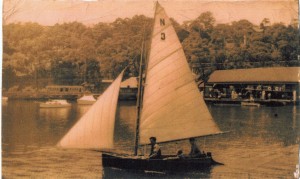 1. Our 12 footer Dawn with my two brothers, me steering sailing in Mosman Bay. Note: Old Mosman tram awaiting passengers Next boat was Dawn, a restricted 12 foot racing skiff also built pre-World War II. We began racing her with North Shore 12 Foot Dinghy Club in 1947/48 whilst Buster Brown (later a well -known MHYC personality) was club secretary at the time (see photos 1- 5). We later moved Dawn to Balmoral 12 footer club then newly formed by Bob Oatley and Billy Buckle. I remember once sailing as 5th hand and 'bailer boy' in a very heavy 12 footer called Gumnut. This 12 was so solid she had to be moved up the beach on wooden rollers as she was too heavy to lift. 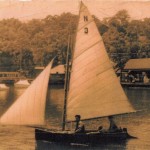 1. Our 12 footer Dawn with my two brothers, me steering sailing in Mosman Bay. Note: Old Mosman tram awaiting passengers 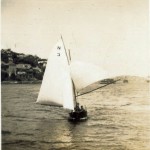 2. Dawn under cross cut cloth spinnaker in Mosman Bay 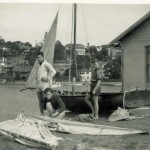 3. My brothers and I rigging Dawn at the North Shore Dinghy Club, Careening Cove opposite the RSYS c1946  4. Dawn after winning its first race. Note the coal burning "Freighter" anchored in Athol bight as was common those days. 1950 SoloAround 1950 we bought a 16 footer from Jimmy O'Rourke called Solo and raced her regularly with the Middle Harbour 16ft Skiff Club along with Jack Lyons, Bob Ferguson, Kenny Beashel, Bill Gale, plus Keith Jones and Ken Mansergh, (old MHYC members) among others. 1954 Sea Bee at MHYCI joined Middle Harbour Yacht Club (MHYC) in 1954 after I had started sailing with the club a year or so earlier crewing with Charlie Bullbrook's Sea Bee. Charlie was commissioned to build the first MHYC premises - now the Coast Guard. I actually assisted building the new club by nailing on weather board planks to the walls as so many club members did. I was also ocean racing in events like the Montague Island race and others on different boats. In those days, most boats did not carry any form of life rails, radios, or other safety gear. 1957 505 Wold ChampionshipsIn 1957 I represented Australia in the 505 World Championships in La Baule, France with a French crew finishing 25 out of 55. I was lucky enough to meet up with Paul Elvstrom who was very helpful to me and I actually ended up buying an old 2/stroke motorbike from Hans Fogg, Paul's crew, who later became a well-known sailor in his own right. I rode this motor bike, no papers, no licence, around Europe racing in Germany and the UK in different dinghy classes. 1959 Kunapipi (ex Miss Dulux)Back in Sydney in 1959, and newly engaged to Jan, my wife to be, I bought Miss Dulux, an 18 foot racing skiff from Alf Beashel, Col Beashel's grandfather, for �50. We fitted her out in 16 footer sails and closed in the foredeck and made her a stem headed rig, no bowsprit, unusual at this time, but still with iron centreboard (fin). All sails were cotton including a second hand Dragon spinnaker purchased from Norm Booth, the well-known Dragon sailor and MHYC member. Spinnaker material was Egyptian Japara cotton silk, the best at this time with nylon about to come into the market. Jan christened her Kunapipi. Great boat, beautifully built with Australian cedar planked hull shape and framed in silver ash. We went on to win every race we entered with the MHYC. I became the FIRST and I believe the ONLY boat owner to be banned from racing with the MHYC. The Club brought in a special new rule outlawing centreboard yachts from racing. I guess Kunapipi was considered just too fast! Around 1960 Rebuild of KinapipiThe banning meant I had to convert Kunapipi into a keel boat to be able to race again so I set about designing a new type of low drag, foil shaped, lead weighted, fin keel to be built in fibreglass, (very new at the time). I hand laid up a foil keel over a male cardboard mold in our Balgowlah flat. I designed an insert of 400 lbs of lead to be hot-cast directly into the bottom of the FRP fin keel (see my first yacht plan). The lead ingots were melted over an open fire on the sand beside Ferguson's boat shed right beside the Spit Bridge where Plonk restaurant now is. I then devised a system to pour two-part, structural polyurethane foam (then a brand new product) into the remaining space right to the top of the FRP hollow keel which was then bolted onto the hull using the bolts pre-cast into the lead. Interesting enough, in those days, the CSR Co was the only supplier of foam which had to be delivered to the beach in two chilled Eskies to be mixed and poured immediately into the space. As far as I am aware, this was the very first such composite fin keel built anywhere and it worked a treat! Syd Ferguson, Bob's elder brother, built a wooden coach house over the open cockpit to my design so Kunapipi became a great little fast keel boat that was a delight to sail and legal to race again with the MHYC (see photo 11). Over a long weekend in 1960 Garry Welch (an old friend and former Royal Prince Alfred Yacht Club (Royal Prince Alfred Yacht Club) and back, meeting our wives on arrival (see photo 12). On the Sunday, it blew a 40 knot westerly while we were in Pittwater's protected waters but we sailed her back to the Spit on the Monday with no problems. As was the habit in those days, we carried no safety gear of any kind with only a couple of inflated rubber tubes for flotation of the open hull! 1961 SachikoIn December 1961 I set about completing the first 30 foot Yachting World Keel Boat out of the UK, plan set number 11. She was called Sachiko (see plans 13 and photos 14 -15) She was a very rudimentary race boat where I hand spiced all the galvanised wire rigging by hand, white leaded, 'parcelled' and 'served' the final splice with marlin line. We designed and built our own cast aluminium drum winches and fitted underdeck ratchet-extended winch handles. They worked well for their day. However, the aluminium mast was another story. One of the first in Australia, it was made in Melbourne by extruding a flat section including track then bending aluminium section around a 5cm wide oregon central spar to make it an oval shape then held together by central screwing the total length of the mast to the wooden spar! Not a great mast and it broke when we were caught by the incoming tide when we were becalmed and dragged under the Spit Bridge. None the less the YW Keelboat was the first planing keelboat in Australia and we won many races. I then was instrumental in starting the YW Keelboat Class in Australia which soon after changed its name to Diamond Class. The new class grew quickly with big fleets racing in every state, running state and national championships for many years. I was winner of state and national championships with Sachiko. 1966In 1966 I had a new YW Keelboat built with varnished topsides and laid beech deck built by Ken Minter and Ron Balkwell in Careening Cove. She was a beautiful Keel Boat indeed. This yacht was Jan, launched in October 1965 and the first of many by this name. I assisted Bob Oatley to have an identical yacht built which Bob raced keenly until he started his famous ocean racing career sometime later (see photos 16-17). 1970 Jan II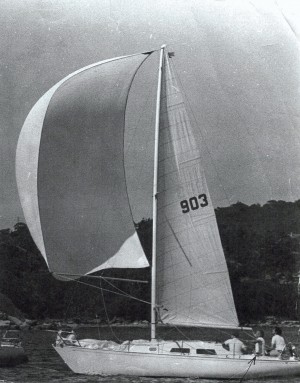 19. Jan II, a Cole 25, racing in Division 2 Offshore, MHYC. Arrow shows Keith Tierney sailing in his first MHYC race. My next boat was a pretty Peter Cole designed Contessa class 25 footer, Jan II launched in 1970. I purchased the bare hull from Gosford builder Bruce Fairley and fitted her out on our front lawn. The accompanying photo of Jan II racing with MHYC shows a very young Keith Tierney working the brace in his first race with MHYC (see photos 18-19). I later nominated Keith for club membership where he became very well-known and later Commodore. I raced Jan II in offshore division 2. She was fast and a delightful yacht to sail and a good boat for a young family. Later, I sailed with Keith in his yacht Kintama. 1974 Jan IIIJan III was next. She was an Etchell 22 class race boat designed in Stamford, Conn, USA in Dec. 1969 by Skip Etchell. Again, I fitted her out on our front lawn. Etchell racing quickly became the premier class for one design racing in Australia and still is. I was fortunate to win many local and state championships, three consecutive national championships plus a third placing while racing from 1974 to 1978 (see photos 20-21) 1976 Etchell World ChampionshipsAs a result, whilst racing with the RPAYC, I was nominated to represent Australia in the 1976 World Championships in Newport, Rhode Island, USA, and was awarded the first International Sailing Grants Committee prize for international travel that was to be the forerunner to all assisted international regatta racing including the Olympics (see photo 22). My crew were John 'Steamer' Stanley and Len Esdaile and we contested the World Championships in Rhode Island with 56 starters from around the world. I took our sails and borrowed a US Etchell. Whilst sailing the final quarter mile to cross the finish line in the last race 7 of the series we only had to finish to claim the World title when race time expired. Race 7 was re-run next day with only 8 boats starting due to end of national holiday weekend. We finally finished 3rd overall in the 1976 World Championships (see photos 23-24). 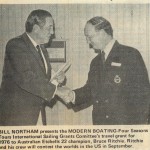 22: Bruce receiving first travel award from Sir William Northam  24: 1976 Etchells 22 World Championships, Newport, Rhode Island, where we finished 3rd place overall 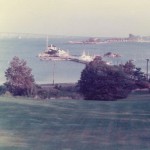 23a: Ida Lewis Yacht Club, Newport 1977 Jan IV 21: Jan IV racing on Harbour with Keith Tierney on sheet. In 1977 together with Keith Tierney we purchased Jan IV which was another Etchell built by Savage and Sons, boat builders, Williamstown, Vic. She was built for us to sail in the 1978 Worlds to be sailed on the Broken Bay Circle conducted by RPAYC. We finished 10th. Keith and I had great fun with this boat (see photo 21)
1979 Jan VIn 1979 the family decided we needed another cruiser/racer, so I designed Jan V (see plans of Seaflyer 9.75 and photos 25-26), a yacht we could cruise in up the Hawkesbury with a young family aboard and be easy to cruise and race. We fitted a self-tacking jib system for this reason which worked well for cruising and racing. I designed Jan V in 1979 as a 31 foot, multi chine, light, West System Epoxy, plywood yacht. Originally, I designed Jan V to have a `winged keel', probably the very first (see photos 27-29 of 1: 25 scale model)! My design theory was for a one piece lead casting with wings splayed out at 45deg. each side of a vertical centre line with the composite fin through-bolted into lead casting. Fin was to mount via a central bearing inside a small fin case and be able to rake (articulate) either 5-8 degrees down at fore end when sailing to windward or 5-8 degrees upwards when sailing downwind thus altering the angle of incidence of the wings to the trajectory of the boat. The design was to generate extra lift when sailing to windward. Similarly, it would create hull lift when sailing downwind. A simple lever arm and tackle was to be fixed to the fin top to alter the rake. I reasoned the wings may assist in reducing leeway and be a positive force rather than a drag inducing bulb. This design seemed very important to me at the time and wing or canting keels had not yet been invented. I first showed the design and scale model to Kenny Beashel asking for a build quote. Ken noted the winged keel. However, Andrew Moncrieff won the build contract but was not keen to use my winged keel idea so conventional cast iron keels were cast. A number of these boats were built. They were fast, had good cruising accommodation and were economical to build. My old friend Ben Lexcen went on to design Australia II with his winged keel that was to become famous after winning the 1983 Americas Cup in Newport, Rhode Island. 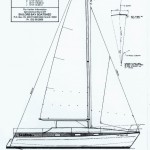 Plans of Seaflyer 9.75 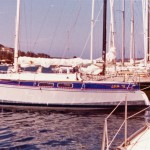 25. Jan V 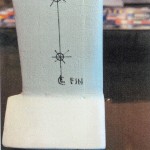 27. Jan V, 1:25 scale model of first Winged Keel 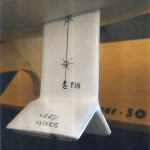 27. Jan V, 1:25 scale model of first Winged Keel  28. Winged Keel showing the 90 deg spread of cast lead Wings.  29. Fin raked aft 5-8 deg for upwind sailing and raked forwards for downwind sailing. Early 1980'a Jan VIMy next yacht, Jan VI, was a 5.5 m yacht designed by Ben Lexcen originally for Frank Tolhurst and built beside Australia II with upside down keel similar to Australia II, but no wings. This keel was not successful and later changed. Frank later sold the 5.5m to me where I made a few basic changes. We won Australian and state titles and in 1986 went on to win the coveted 58th Scandinavian Gold Cup (first sailed for in 1922) in a match race sail off against Finland (see photos 30-31). The Gold Cup was a very old, valuable, and highly sought after trophy in those days. In 1987 we took Jan Vi to Hanko, Norway for the World Championships along with my wife Jan and a young crew including Andrew Cutler who now sails on Revolver when he gets the time. Mid regatta King Olav V, King of Norway, who we were racing against, invited Jan, crew and me on board the Royal Yacht to celebrate his birthday whereupon we were piped aboard in proper Royal/naval style. We mingled with members of the Royal family including the Prime Minister of the country. We finished top Australian boat. Jan VI was sold in Norway. 1986 Japan - True Blue 30In 1986 I was approached by Gaastra Sails, Tokyo, to design and build a series of club race yachts for Japan with construction similar to the Jan V concept of light displacement, multi chine, epoxy/ply construction. The design had to be fast down wind. (see plans 32). First yacht was finished in time for the last race of the CYC winter series which happened to be ladies day race. The Japanese team came out especially to trial their first boat only to have to have it sailed by a lady! I asked Rowena Wilmot to steer her on Gaastra's behalf and for the Japanese to crew. She won from scratch by many minutes beating all corners including the fleet of Etchells across the line by some 3 minutes and the others by 22 minutes after starting from scratch. The Japanese Gaastra team were delighted (see photos 33-35). An interesting feature of these yachts was the sigmoidal or S-shaped fin keel I designed to have the narrowest chord width possible to reduce induced drag downwind yet provide enough lateral resistance and improved lift qualities upwind. As there was a depth restriction the sigmoidal fin/keel design was the result and the yachts proved to be very fast racing in Japan. 1987 America's Cup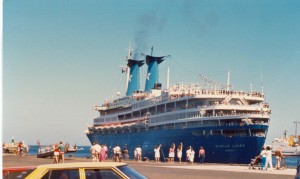 36. Cruise Ship Achille Lauro leaving Fremantle Harbour to watch the Americas Cup. Bruce Ritchie directed where the ship went and conducted race commentary aboard vessel. January 1987 was Americas Cup in Fremantle. I was asked to do the live race commentary from the bridge of the Italian cruise ship Achille Lauro (see photo 36). I was offered a first class cabin suite accommodation for Jan and me which included all meals and an open bar account. Good deal! I had to attend the Cruise Ship Captains Meeting each morning at the wharf office representing the Achille Lauro before racing as our captain did not speak English well enough. As I was the local expert I made sure our cruise liner got the best position to watch each race. Jan and I thoroughly enjoyed ourselves with the hundreds of race watchers on board each day who included Tig and Mavis Thomas (see photos37-38).. Sadly Tig, ex MHYC Commodore twice over, recently passed away. 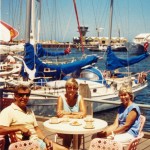 37. Gilbert Thomas (Tig) and Mavis with Jan before boarding. 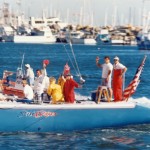 38. Denis Conner sailing Stars & Stripes back into Fremantle after winning the Americas Cup for the 2nd time. 1990 Ritual1993 Cabriolet Royal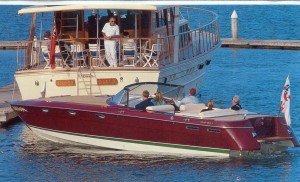 40. Cabriolet Royal luxury, classic speedboat with top down. She held 6 passengers in great comfort. In 1993 I got the urge to design a luxury, fast, Italian style speedboat for limited production. This project was just one which I wanted to do. I called the class Cabriolet Royal. The 34 ft. hull design was based on the famous US race boat Cigarette. She had a 24 degree deep V hull shape with FRP balsa cored construction with various power options offered. We built boats with twin jet drives, twin Volvo V8 petrol and diesel motors, twin 300 HP Mercruiser V8s, all with duoprops capable of over 40knts.
I personally sold a special powered version to Kerry Packer - he asked for a boat capable of 60 knots so we installed twin 415hp big block V8s Mercs which gave him a top speed of 70 knots.
I often saw Kerry running his Cabriolet Royal on Sydney Harbour. I believe this boat is still in the Packer family aboard their mega-yacht as a tender (see photos 40-44). Especially for this project I invented Image Fibre, a wood look-a-like system for FRP constructions (patents applied). The first laminate was of thin, special, glass fibre tissue where we printed an image of real mahogany wood onto the tissue via a rotary lithographic printing press.
The initial gelcoat was tinted a red mahogany colour and the final result was that the hull looked like real mahogany timber even close up but was actually 100% FRP. This patented process proved a great success (see photo 43).
Cabriolet Royal had a convertible soft top, electric side windows with a luxury fitout below of galley, toilet, saloon and V berth forward. I exhibited in 2 Sydney, 1 Brisbane, and 2 Palm Beach, Florida boat shows selling a number of boats.
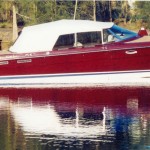 41. Cabriolet Royal. with hood and electrical windows up. 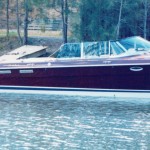 42. Cabriolet Royal. with hood down and electrical windows up she showed protection and comfort 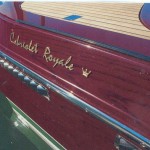 43. Image Fibre (patented invention of Bruce Ritchie) was a FRP wood grained surface feature that looked like read wood even when close up. 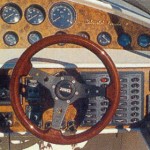 44. Showing the controls and cockpit comforts 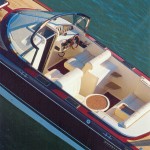 44. Showing the controls and cockpit comforts  44. Showing the controls and cockpit comforts Sydney Boat ShowAt the Sydney Boat Show we were visited by the then young NZ industrialist Greg Goodman who so liked what we did with the Cabriolet Royal that he invited me to a meeting with his two brothers to discuss the notion of a large sports fishing motor yacht of around 75 to 80 feet. It was agreed that I draw up a conceptual design to meet their ideas (see my original concept drawing 45). My drawing was accepted and the 80 ft, sports fishing motor yacht Nelson I was quickly built and I believe she was much loved by the brothers Jan VIIAs a commercial venture the speed boats were not all that successful but great fun so we went back to personal sail boats. So next boat was Jan VII, an old Etchell. We raced her a bit with harbour and MHYC fleets for a short time.
Jan VIIINext yacht was Jan VIII, the old RPAYC 6 metre race yacht; "Prince Alfred II" converted to a cruiser/racer. She was a fine looking boat but very narrow-beamed as 6 metres were, not very fast, a pig to sail and not that suitable for family use (see photos 46-47) Jan IXIn 2001 the next yacht was Jan IX, a German built Dehler 36 cruiser/racer. Beautifully built and well detailed with electric winches, toilet, and autopilot thus considerable cruising comforts. We raced her with middling success with MHYC but for family cruising she was great. A very refined yacht indeed. (see photos 48-49). UnionIn 2003 my elder son Michael and I purchased a Bavaria Match 42 which we called Union (as an indication of father and son ownership). Union was a great live aboard cruiser/racing yacht. We were quite successful in racing her both inshore and offshore wining the Port Stephen's Regatta twice running. We also raced her in the Hamilton Island Race Week finishing mid fleet and enjoying ourselves greatly. We altered the keel configuration 3 times in an endeavour to improve performance with reasonable success. Union was a good family boat, well built, very comfortable for cruising and reasonably fast. (see photos 50-52) 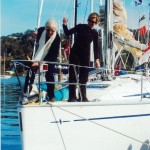 50. Jan and Melanie Ritchie launching Union at RPAYC 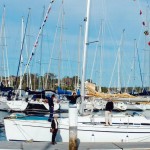 50. Jan and Melanie Ritchie launching Union at RPAYC  51. Union racing in Hamilton Island Race Week  51. Union racing in Hamilton Island Race Week 2014 RevolverIn 2014 we sought new challenges, new experiences for our sailing so Michael and I decided to sell Union and buy a fast harbour sailor. We looked the world over and could not find anything that satisfied our new needs so Michael suggested that I should design a yacht from scratch that could meet our requirements. I could not think of anything better than deigning a boat without constraints and supervising her build. Potentially great fun and that's how it turned out to be! Our requirements were clear: She had to look great in the modern sense, plane downwind at 20 knots plus, sail well to windward, be able to be sailed single handed, able to race with a small crew for non-spinnaker events when required by Michael, be powered by renewable electric energy rather than diesel, have a lifting keel and rudder so yacht could be brought in to shallow water, full carbon rig and sails, base structure in epoxy/wood and fully carbon laminated outer hull shell for strength and lightness, costs to be within reason. The build was awarded to Sean Langman of Noakes Shipyards, Berry's Bay. I consider that we were lucky to have had Noakes as our builders. They were great to work with, professional and built us a beautiful yacht. She was to be a 38 footer called Revolver, the company name of Michael's business in the film industry. I drew up hull lines, sail areas and rig plans, keel design (see plans 53) and displacement targets and the actual build method which was unique. I decided that we would build in light, 9mm Gaboon ply for all frames, topsides, deck and cockpit areas with bottom diagonally planked. Stringers, chines and gunwales and keel to be hoop pine with protection via epoxy, Everdure and Bote Cote. The completed hull was to be wrapped in multiple carbon cloth laminates, vacuum bagged and post-heat cured for strength and durability. Thus we ended up with a light, solid core carbon race yacht. We appointed Will Hardcastle of Peter Lowe Design to ensure structure was to ISO 12215 and 15012217 standards and design up parts as required by Noakes. Will faired up my hull lines, digitized them, then forwarded files to a Brookvale CNC cutter. All 10 Gaboon frames were quickly cut to very accurate tolerances and delivered to Noakes for assembly. Noakes were able to erect frames into build jig and fit pine stringers, chines, keelson very quickly thus eliminating the need to loft out the lines full size. Often such frames are only used to form up the hull shape over which finished hull is completed then frames discarded. However, we left frames institute as part of finished structure thus saving time and materials and ensuring a light hull weight with an all up displacement of just 3,300kgs. (see photos 54-56). The finished structure actually gave us a male mould over which Noakes directly laid up the carbon laminates, vacuum bagging and finally post-heat curing the hull structure. This method saved us the cost and time of building separate moulds. Will Hardcastle was a tower of strength from start to finish with his consistent attention to the needs of the venture. Carbon spars and rigging were from NZ Rigging. Carbon 2m bowsprit and rudder were built by Noakes. We imported an Oceanvolt electric motor system from Finland including saildrive with Gori propeller, 8 lithium ion batteries from Texas and 7 light roll up solar panels from Holland for battery charging. Charging is either from shore power at RPAYC marina, via sola which is amazingly efficient or via pressing a button on controls which engages the Gori propeller to hydro charge battery bank whist sailing along at say 5 to 6 knots. Hydro prop drag is not noticeable. Electric power has been a wonderful success. Sails are Italian moulded carbon form Hood. The Bisaloy 80 steel fin was milled and fitted to 1000kg lead bulb by Williams Tool and Engineering at Chipping Norton. I designed and carved the foam shape for lead casting ( see photos 57-58). It is known that end plate cavitation around trailing edge of lead bulb shapes can cause unintended vortices and or cavitation induced drag. I sort to eliminate unwanted drag problems by designing what I call a Tracking Foil to both reduce risk of drag and to also assist bulb to track through turbulent waters. The hardened stainless foil seems to have worked! (See photo 59). Below she is fitted with 4 bench seats, a toilet and V berth forward. Revolver was launched by Jan at Noakes October 2015 (see photo 60-61) and has sailed above our highest expectations ever since (see photo 62 of Revolver on her maiden sail out from Noakes Berry's Bay ship yard). Revolver has proved to be very fast reaching and running with consistently high planing speeds of 17knts to 20knts and usually sailing faster than wind speed. She is light and easy to handle, can sailed single handed and raced very competitively when fully crewed as a Div. 1 RPAYC yacht under her Code 0 or big asymmetric spinnaker. For cruising and Wednesday non-spinnaker type racing she has a carbon, self-tacking, jib boom which deploys jib out at 90 degs. to centre line thus running without the need of a separate pole. We also reef jib down to this pole when required. All round - a very fine gentleman's harbour racer (see photos 63-64). 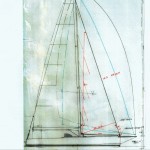 53. Plans for Revolver  53. Plans for Revolver 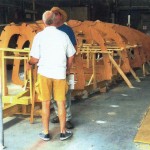 54. CNC cut frames quickly being assembled onto build jig ready for keel, chines and gunwales to be fitted. 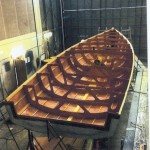 55. Hull ready for decking and awaiting turnover for carbon laminates. 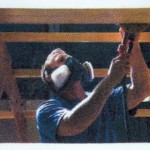 55. Hull ready for decking and awaiting turnover for carbon laminates.  56. Hull displaying its planing shape 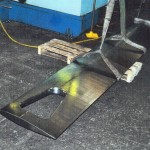 57. Bisoloy 80 milled steel fin and lead bulb fitted. 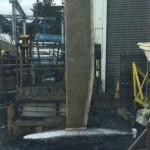 57. Bisoloy 80 milled steel fin and lead bulb fitted. 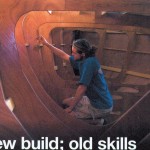 58. Peter Langman working inside hull. 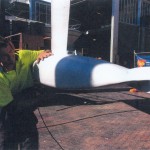 59. Tracking Foil shown in place on bulb.  60. Jan pouring champagne over bow at launching of Revelver 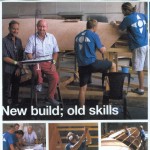 61. Michael, Bruce, Sean Langman and others 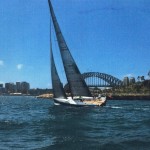 62. Revolver on her maiden sail from Noakes yard Berry's Bay. She performed beautifully. 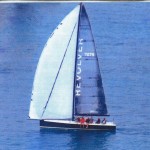 63. Revolver  64. Revolver racing in the 2017 Opening Day race finished 2nd overall in Div 1. |
|
|



